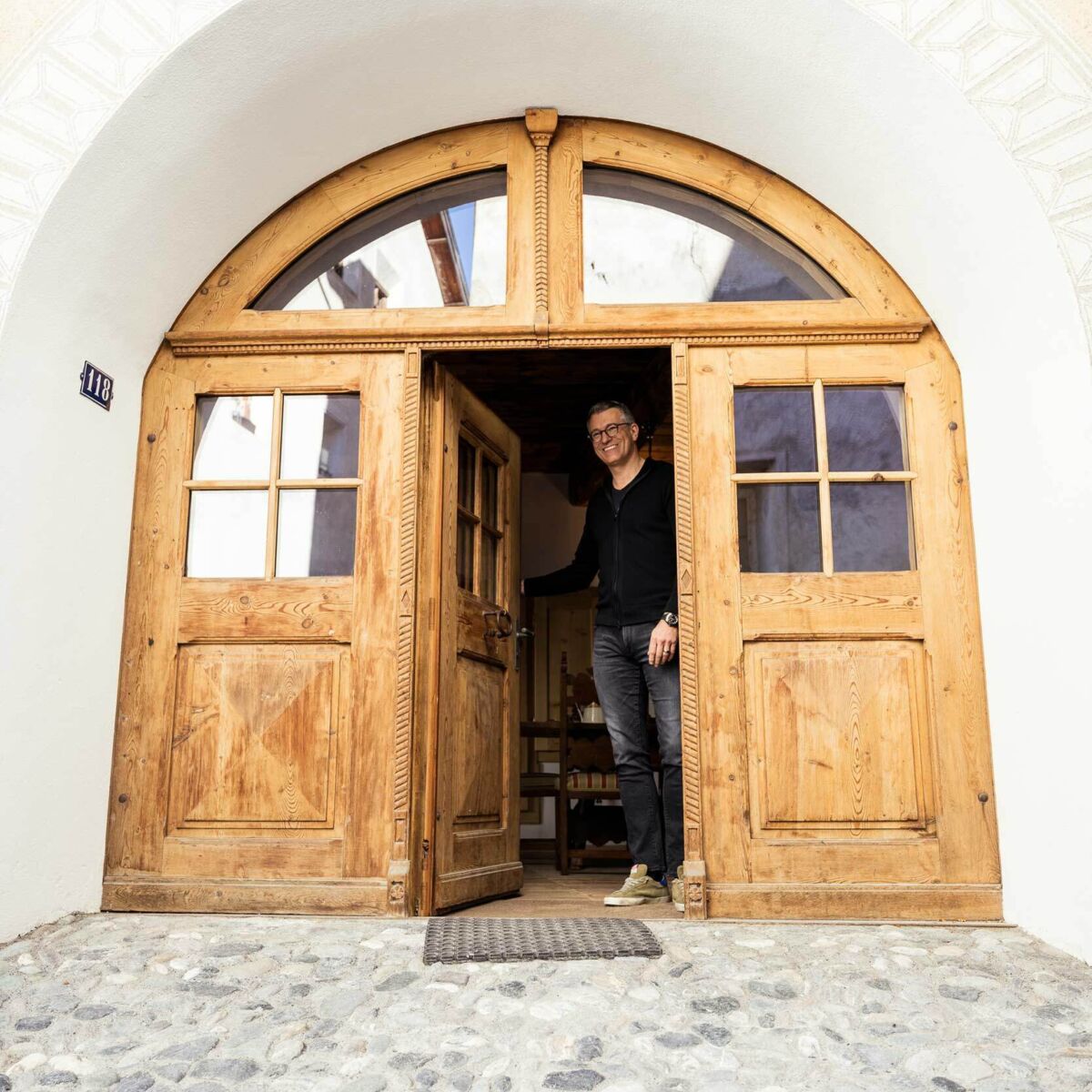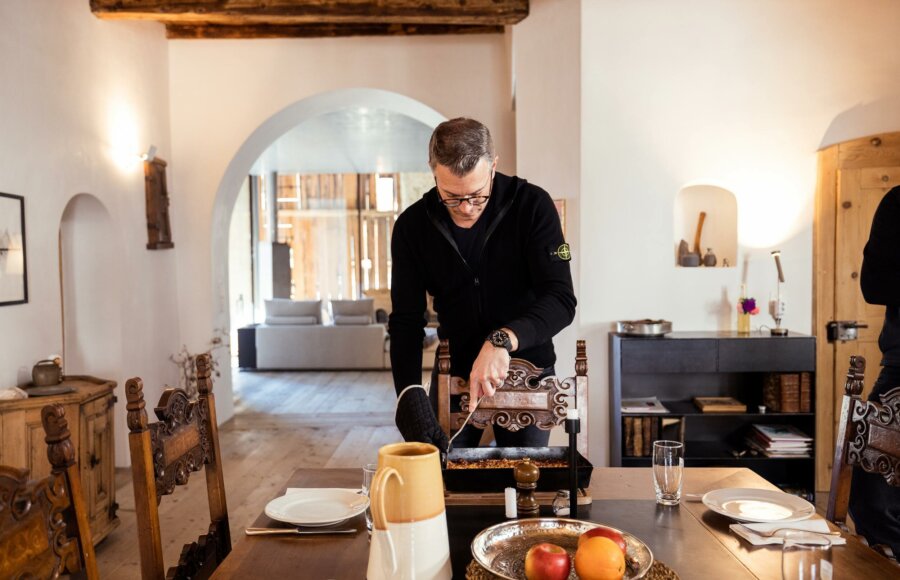
A lot of Reto Vonzun’s daily life focuses on legal matters – everything else is devoted to an ancient house in Lower Engadin. What all that has to do with Ai Weiwei is explained by Vonzun at the table.
“I am a terrible lawyer”, jokes Reto Vonzun as he serves up the food, “but a good cook.” In a cast iron oven-proof dish, he serves the traditional Engadin farmer’s meal of Plain in Pigna. A resourceful way of using up leftovers which everyone makes in their own fashion. Vonzun is guided by the hand-written recipe of his father: coarsely grate waxy potatoes, mix with polenta, flour, diced bacon, salami and a cup of milk, resist the urge to add salt and pepper – and bake it all in the oven until the crust turns a crispy brown. “My father writes that it needs a salad with it”, explains Vonzun. “But I think salad is overrated.” He is a purist. To drink, he serves cold tap water.

«My father writes that it needs a salad with it», explains Vonzun. «But I think salad is overrated.»
Not only is Vonzun confident in his own culinary skills, his visitor Duri Vital is too. The architect lives a 15-minute drive away and is a friend of Vonzun. Vital calls the Plain in Pigna nothing more than an Engadin pizza, but only because he is allowed to. The 65-year-old was born here and has never moved. An Engadiner through and through.
Vonzun spends most of the year in the Basel municipality of Riehen. But for about five weeks a year, even six in a good year, he comes here. One of the old, graffiti-decorated farmhouses in the heart of the mountain village of Ardez in Grisons has been owned by his family for centuries.
The Vonzuns are one of those long-established families in the area – dating back long before the beginning of the 17th century. In the midst of the Thirty Years’ War, almost the whole of Ardez fell victim to the raids of the Austrian general Alois Baldiron. The flames consumed the streets and the houses burned down to the ground. Vonzun’s grandmother grew up in one of the houses that was rebuilt soon afterwards. “They lived very modestly”, he says. “In real poverty.” The kitchen (“chadafö” in Romansh) originally consisted of an open fireplace, and apart from the parlour (“stüva”) and the parental bedroom located above it, none of the rooms was heated even when the temperatures fell below zero in winter.
«An unusual architect», recalls Reto Vonzun, «met an unusual lawyer.»
Wherever people talk about the tradition of Engadin houses, the conversation soon turns to Duri Vital: he has now renovated about 50 farmhouses. In doing so, he does not even see himself as an architect: “I am a builder, self-taught.” He worked as a car mechanic and metalworker, ending up in architecture rather by accident. According to the myth, at some point an English architect somehow ended up in a house that he had converted and she is supposed to have said: “This is just what I want.” And now Vital sits here, having lunch in the new old house of the Vonzuns.
How did this come about? “An unusual architect”, recalls Reto Vonzun, “met an unusual lawyer.” For Vonzun as for Vital, trust is at the heart of everything they do. Vital usually renovates houses without any drawn plans and rarely draws up a quote. “If the chemistry with the client is not right, a project will not work.” Vonzun hardly ever wears a suit, even in the law firm. “My clients want me, not my tie.” Two people with the human touch. A recipe for a good team.
«My clients want me, not my tie.»
If the unusual architect had turned down the enquiry of the unusual lawyer back then, the world would have had to do with one friendship fewer. And as Vonzun emphasises: with one renovation fewer, too. “I only wanted to do this project with Duri”, he says. “I am really proud of that”, says Vital. And Vonzun replies: “Credit where it is due.” The stages of the conversion stretched over two years and Vital could be found on site every day. It is important to him to preserve the original character of a house.
The centrepiece of their collaboration is the barn, for both Vonzun and Vital: they had every individual plank taken out, cleaned and replaced. The supporting beams were moved, the lime wash on the ceiling removed. Even the cattle troughs have been preserved: “You rarely find that in a renovated house”, says Vonzun. And Vital adds: “It is always a pleasure to be here.” The gallery owner who, in the first summer of the pandemic, exhibited three works by the Chinese star artist Ai Weiwei here where the cows used to eat, must have seen things the same way. One day during the exhibition, when the house door was accidentally left open, the visitors streamed into the living area instead of the barn one floor below. Vonzun just laughed. “I do not know the first thing about art”, he jokes. It is the stories behind the art and the artists that appealed to him.
The misdirected visitors also had plenty to see in the living area: it is full of works of art. Somewhere there is a portrait of Vonzun’s father as a young man on the wall. “One of my relatives, Anny Vonzun, lived off painting in return for board and lodging during the Second World War.” In another place, there is a piece of Chinese marble framed in plaster, which looks like an acrylic painting. And in the back corner of the glazed living cube, in what used to be the hay barn, there are two silver sculptures. The sculptures, like the marble, come from Not Vital, Duri’s brother. “They are numerical portraits made by the famous silversmiths of the Tuareg in Niger”, explains Vonzun.
The sculptures consist of two rectangular blocks. One for the body, one for the head. “I am the one on the left, with the tiny brain”, says Vonzun. He cannot do much about it: the dimensions of the two rectangles are based on the dates of birth of their subjects. Reto Vonzun, born on 3.9.1972: the head measures three by three by nine centimetres, the body nineteen by nineteen by seventy-two centimetres. The second sculpture is one centimetre taller, the year of birth is 1973, and the head is also significantly larger – Vonzun’s wife. “At some point, we will move here”, says the native son of Ardez in his Basel dialect. The house will surely outlast him.
Reto Vonzun
has been working at Walder Wyss for just under eight years. At that time, the partner left a law firm in Basel with around 20 other people – the moment when Walder Wyss was born in the city on the bend in the Rhine. Despite his many years of experience, you never see the lawyer in a suit and tie. He even talks to most of his clients in an informal way. “I am a lawyer because I cannot do anything else”, he says laughing. Legal matters are a means to an end for him; his focus is on interpersonal relationships. Vonzun is married with three children. The family spends their holidays in a farmhouse in Engadin, a family inheritance.